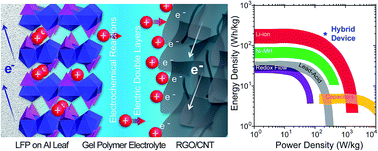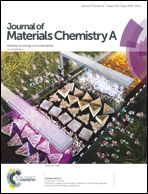A solid state energy storage device with supercapacitor–battery hybrid design†
Abstract
High power and high energy density are important requirements for advanced energy storage systems in mobile electronic devices, electric vehicles, and military-grade high-rate energy storage systems. However, achieving both high power and high energy in a single device is very challenging because high power density usually leads to a tradeoff with low energy density in devices that rely on a single ion storage mechanism. In this work, we designed a hybrid energy storage device consisting of an intercalative battery cathode and a capacitive supercapacitor anode. As a proof-of-concept, we used LiFePO4 (LFP) nanoparticles on an aluminum (Al) leaf current collector as the battery electrode and a free-standing reduced graphene oxide/carbon nanotube (RGO/CNT) nanocarbon membrane as the supercapacitor electrode. The hybrid device possesses outstanding features including (1) an asymmetric electrode configuration; (2) an ultra-lightweight current collector for the cathode; (3) a current collector free anode; (4) a quasi-solid-state gel polymer electrolyte. Compared with conventional supercapacitors and lithium-ion batteries, our hybrid device exhibits superior performance with both high energy density (180 W h kg−1) and high power density (218 W kg−1), and enhanced safety imparted by the quasi-solid-state gel electrolyte, representing one new direction for developing high-energy/high-power energy storage devices.



 Please wait while we load your content...
Please wait while we load your content...